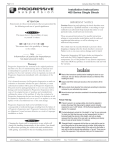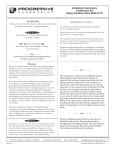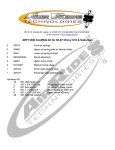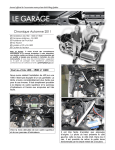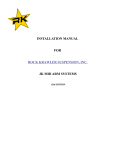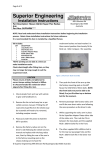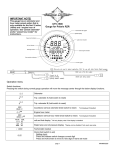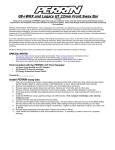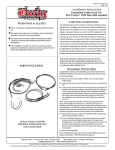Download 3081-005 Inst, RZR
Transcript
Installation Instructions Adjustable Front-Sway Bar Clamps 2008 Polaris Ranger RZR ATTENTION Statements in these instructions that are preceded by the following words are of special significance: Important Notice Caution: Follow instructions in an authorized shop manual or take the vehicle to a competent dealer. The vehicle must be securely blocked to prevent it from dropping while installing the sway-bar clamps. Failure to do so can cause serious damage and/or injury. W a r n i n g This means there is the possibility of injury to yourself or others. Progressive Suspension Adjustable Sway-Bar clamps are designed to work with the OEM (Original Equipment) sway-bar, frame, and A-arms. Use of this system on a swaybar, frame, or A-arms other than OEM may produce unsatisfactory performance and void the warranty. Caution This means there is the possibility of damage to the vehicle. Note Be sure to refer to instruction supplements provided in any included mounting hardware Information of particular importance has been placed in italics. Installation Warranty Progressive Suspension Inc. warrants to the original purchaser this Part to be free of manufacturing defects in materials and workmanship for a period of one (1) year from the date of purchase. In the event warranty service is required, you must call Progressive Suspension immediately with a description of the problem. If it is deemed necessary for Progressive Suspension to make an evaluation to determine whether the part is defective, a return authorization number will be given by Progressive Suspension. The parts must be packaged properly so as to not cause further damage and returned prepaid to Progressive Suspension with a copy of the original invoice of purchase and a detailed letter outlining the nature of the problem. If after the evaluation by Progressive Suspension the part was found to be defective it will be repaired or replaced at no cost to you. If we replace it, we may replace it with a reconditioned one of the same design. 1. It is recommended that the vehicle have the front wheels lifted securely off the ground so as to evenly unload the front suspension. Alternately, the sway-bar clamps can be replaced while the vehicle is sitting on the ground - as long as the ground is level and the vehicle has the front suspension loaded equally side to side. 2. Remove the nut, bolt, & washer going through the upper rod end and stock sway-bar clamp and set aside, as these will be re-used (see figure 1). Remove the stock sway-bar clamp from the sway-bar. This may require wedging a flat screwdriver into the slot to open up the sway-bar clamp enough to slide off the sway-bar. Repeat on other side. Sway-Bar Progressive Suspension shall not be held liable for any consequential or incidental damages resulting from the failure of a Progressive Suspension part. Progressive Suspension shall have no obligation if a part becomes defective as a result of improper installation or abuse. Stock Clamp Bolt Rod Warning Changing the chassis and/or suspension on any vehicle will change the handling characteristics of that vehicle. Care should be taken when operating the vehicle with such modifications while getting accustomed to the new handling characteristics. 6900 Marlin Circle, La Palma, CA 90623 Page1/2 Tech line: 714.523.8700 Forward Figure 1 Fax: 714.523.3220 (right side shown) www.progressivesuspension.com Instruction Sheet Part # 3081-005 Rev. B 3. Slide the Progressive Suspension Adjustable Sway-bar Clamp onto the end of the stock sway-bar and orient as illustrated below (figure 2 & 3). Be sure to slide it all the way on until it bottoms in the hole. Install two supplied M6-1.0X20 SHCS into the bracket and torque to 85 in/lbs. Re-install the rod end using the stock nut, bolt, & washer - installing the bolt through the rod end, then washer, then clamp, and finally the nut - into one of the three available mounting holes. Though the furthest forward hole mimics the performance of the stock mounting clamp, we recommend reinstalling the rod end using the middle mounting holes in the adjustable clamps. Our testing has shown this setting to virtually eliminate the RZR’s tendency to go from under-steer to snap over-steer while cornering. Torque the nut and bolt to the specification called out in a factory authorized service manual. Repeat on other side. NOTE: there is no left or right bracket, so the SHCS will go in from the inside on one side and the outside on the other. Forward SHCS Adjustable Clamp Figure 2 (left side shown) SHCS Figure 3 Page 2/2 Adjustment By installing Progressive Suspension’s adjustable sway-bar clamp, you now have the ability to adjust the effectiveness of your sway-bar to better suit your driving style . To better understand the function of these adjustments, let's examine the general dynamics of what the Sway-Bar is actually doing. In the simplest terms, a Sway-Bar is designed to reduce body roll. It keeps your vehicle flatter in the turns by transferring the force exerted on the outboard wheels and applying opposite force on the inboard wheels. In this way weight is more evenly applied to all four wheels, helping the vehicle stay more level with the road. The amount of force transferred from one side to the other is determined by various factors such as length, shape, and thickness of the Sway-Bar. Other crucial factors are the mounting points which determine the leverage ratio, and your Progressive Suspension Adjustable Sway-Bar clamp has three different mounting holes on each side to choose from which gives you THREE different levels of force transference: · Forward holes give you MAXIMUM force. · Center holes give you MEDIUM force. · Rear holes give you MINIMUM force. The reason the force changes is a result of the effective leverage on the Sway-Bar. You will find these adjustments make a dramatic difference in the steering characteristics of the vehicle. For example, under certain circumstances less front body roll tends to lift the inside front wheel thus reducing overall traction and slowing or delaying the turning action. Under the same conditions, too much front body roll, such as with no front sway-bar, could produce quicker steering action which tends to lift the inside rear wheel - which may increase the risk of vehicle roll over. As with most suspension/chassis adjustments, it’s a balance that needs to be adjusted to the driver and conditions for optimum performance. Changing the chassis and/or suspension on any vehicle will change the handling characteristics of that vehicle. Care should be taken when operating the vehicle with such modifications while getting accustomed to the new handling characteristics. (left side shown) Instruction Sheet Part # 3081-005 Rev. B


